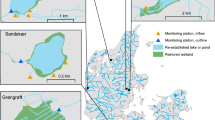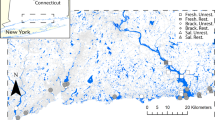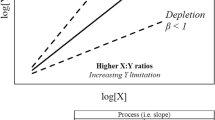Abstract
Wetlands are created or restored for a number of purposes, including flood control, water purification, sediment and nutrient retention, and biodiversity. Restoration of wetlands is the process of recreating former conditions at a site that once contained a wetland. Restoration and creation of wetlands involve the creation or restoration of hydrology, but may also include activities that alter soil composition, manipulate vegetative communities, or promote target wetland functions. Carbon accumulation in restored and created wetlands is dependent on hydrology, vascular vegetation, and microbial communities. Once hydrology is restored, consistent periods of soil inundation reduce rates of microbial decomposition by creating anoxic soils. Wetlands prior to restoration and terrestrial soils prior to development of wetland hydrology are usually carbon poor, and created wetlands often retain soil properties from the soils from which they are created, potentially taking tens of decades to build up carbon reserves similar to natural wetlands. Initial nitrogen pools reflect past land use. Agricultural sites are increasingly being converted into wetlands, resulting in many restored or created wetlands with large initial nitrogen pools due to legacy effects of fertilizer use. Since nitrogen removal via denitrification is often desirable in restored and created wetlands, increasing the duration of inundation in restored or created wetlands may be used to encourage denitrification, but microbial community biomass often is still limited by available organic carbon. Unlike carbon and nitrogen, phosphorus cycling in wetlands is primarily controlled by abiotic processes. Increasing water residence time and depth have been shown to increase soil phosphorus sorption. However, in restored or constructed wetland phosphorus release may occur in sites that initially contain elevated phosphorous levels in the soil, such as sites with agricultural legacies. Overall, the retention and recycling of carbon, nitrogen, and phosphorus are controlled by a variety of biotic and abiotic processes, themselves influenced by ambient oxygen and for restored wetlands initial nutrient concentrations that become less important over time.
Access provided by CONRICYT-eBooks. Download reference work entry PDF
Similar content being viewed by others
Keywords
Introduction
Wetlands are created or restored for a number of purposes, including flood control, water purification, sediment and nutrient retention, and biodiversity (Mitsch and Gosselink 1993). Restoration of wetlands is the process of recreating former conditions at a site that once contained a wetland. Wetland creation involves manipulating a site without a historical wetland so that it functions as a wetland. Success of wetland creation or restoration is usually determined by comparing structural (hydrology, vegetation structure) and functional (carbon and nutrient cycling) elements of the new wetland with a natural system. The new wetland will ideally be a natural, functioning, self-regulating system that is integrated within the ecological landscape in which it occurs (Palmer et al. 1997).
Restoration and Creation of Wetlands
Restoration and creation of wetlands involve the creation or restoration of hydrology but may also include activities that alter soil composition, manipulate vegetative communities, or promote target wetland functions. Developing wetland hydrology often involves the removal of dams, dikes, levees, or tide gates to restore the periodic inundation required to establish wetland vegetation and soils. Vegetative plantings, seeding, or manipulation of soil nutrient and carbon pools may be used to try to accelerate the return of wetland structure and function, although many elements of wetland structure and function only develop after prerequisite structure or function has developed.
Once hydrology is reestablished, wetlands theoretically follow general developmental trajectories that approach the structure and function of natural wetlands over several decades. In practice, wetland development is rarely smooth or rapid, and many restored and created wetlands fail to reach structural or functional equivalency (Moreno-Mateos et al. 2012). Despite these limitations, general developmental patterns can be observed in restored and created wetlands. Processes that depend on wetland structure return relatively quickly. Vegetation establishes rapidly after the restoration or creation of wetland hydrology, within 1–3 years. Processes that depend on vegetation including sedimentation, surface water hydrology, and the rates of soil carbon and nitrogen accumulation achieve equivalence with natural marshes soon after vegetation establishment, generally within 5 years. These measurements are still not sufficient, however, to conclude that a restored or constructed marsh has achieved equivalence with a natural system. Vegetation structure, higher trophic level diversity, and benthic infauna abundance depend on carbon and nutrient pools which take significantly longer to reach parity with natural systems (Craft et al. 1988; Craft 2000). Wetland nitrogen pools begin to develop within a few years of wetland creation, but may require as long as 30–40 years for soil pools to reach equivalence, and soil carbon pools may only approximate a natural system after 70 years or longer (Fig. 1, Craft et al. 1999; Craft et al. 2003; Moreno-Mateos et al. 2012).
Trajectories describing changes in functional and structural attributes during salt marsh ecosystem development (Figure recreated from Craft et al. 2003; used with permission from the Ecological Society of America and Wiley)
Carbon and Nutrient Cycling
Carbon accumulation in restored and created wetlands is dependent on hydrology, vascular vegetation, and microbial communities. Once hydrology is restored, consistent periods of soil inundation reduce rates of microbial decomposition by creating anoxic soils. Increased duration of inundation further decreases decomposition rates, which can create heterogeneity of decomposition rates and carbon pools within or among wetlands (Serna et al. 2013). Other factors that can affect decomposition rates include the quality and quantity of detritus additions, soil characteristics, and temperature which can vary both with season and with latitude. Since carbon input is highly dependent on vascular vegetation detritus, rates of carbon accumulation in restored marshes are similar to natural marshes within 3–5 years of the restoration of wetland hydrology, coincident with the development of aboveground biomass production (Craft et al. 2003).
The vertical gradient of carbon quality (C:N ratio) in restored and created wetlands is initially exacerbated relative to natural wetlands. In all wetlands, labile carbon fractions are decomposed more rapidly than recalcitrant forms resulting in a gradient in the soil profile of carbon where shallow, more recently deposited soil carbon is more decomposable than deeper carbon. In created or restored wetlands, this pattern is exaggerated. Initial detrital inputs are higher in quality compared to natural systems. In constructed and restored wetlands, live roots make up a larger proportion of vegetative material relative to natural wetlands where decomposing roots predominate. The increased quality of carbon inputs to the soil organic carbon pool drives the initial development of decomposer activity.
Initial carbon pools are smaller than natural sites and may take tens of decades to reach equivalency. Restored and created wetlands often retain soil properties from the soils from which they are created. Wetlands prior to restoration and terrestrial soils prior to development of wetland hydrology are usually carbon-poor, resulting in wetlands that have smaller carbon pools relative to natural sites. Evidence from long-term studies suggests that carbon pools are one of the last features to develop and may require 70 years or longer to achieve equivalency (Craft et al. 2003; Ballantine and Schneider 2009; Moreno-Mateos et al. 2012).
Nitrogen retention in wetlands is tied to the vegetation community. Nitrogen retention is initially higher in restored or created wetlands due to high demand from developing vegetation. The nitrogen retention during this period can be 2–4 times greater than retention in natural wetlands. After the establishment of vegetation biomass, nitrogen retention slows, eventually returning to rates similar to those observed in natural marshes.
Initial nitrogen pools reflect past land use. Agricultural sites are increasingly being converted into wetlands, resulting in many restored or created wetlands with large initial nitrogen pools due to legacy effects of fertilizer use. Despite increased nitrogen availability, former agricultural sites still exhibit increased nitrogen demand during the vegetation development period, although areal nitrogen retention may be depressed (Ardón et al. 2010). Conversion of other terrestrial lands or restoration of former wetlands generally results in a small initial nitrogen pool relative to natural wetlands.
Rates of nitrification and denitirification are controlled by the microbial community and nitrogen loading. The total microbial biomass is limited by the availability of soil organic matter, in turn limiting the amount of nitrogen that can be transformed. Since nitrogen removal via denitrification is often desirable in restored and created wetlands, increasing the duration of inundation in restored or created wetlands may be used to encourage denitrification, but microbial community biomass often is still limited by available organic carbon. Rates of denitrification approach the rates of natural wetland after some buildup of soil organic matter in the soil, usually between 5 and 15 years after creation or restoration (Craft et al. 2002).
Equivalency of soil nitrogen pools between created or restored wetlands and natural wetlands may take decades. The buildup of soil nitrogen pools is slowed by denitrification losses of nitrogen to the atmosphere and relies on sequestering organic nitrogen in soil organic matter. Equivalency of soil nitrogen pools in restored or created wetlands with natural wetlands requires approximately 30–40 years (Craft et al. 2003).
Unlike carbon and nitrogen, phosphorous cycling in wetlands is primarily controlled by abiotic processes. Phosphorous inputs into wetlands are dissolved in surface water in both inorganic and organic forms or bound to sedimentary particles. Retention of soil-bound particulate phosphorus is controlled by sediment deposition, a process closely tied to hydrology. Initially, sediment deposition in restored or created wetlands is higher than in natural wetlands. This is partly due to the establishment of vascular vegetation which alters surface water hydrology, slowing flowing waters and allowing more suspended particles to deposit. Over 1–3 years, the rates of sedimentation of slow and available binding sites for phosphorous are reduced, slowing the rate of phosphorous sequestration. Long-term maximum rates of phosphorus retention across wetland types are around 1 g P m−2 year−1 (Richardson and Qian 1999).
Retention of soluble phosphorus involves several geochemical and biological mechanisms. Geochemical mechanisms include complexation of phosphorus with iron, aluminum, and calcium present in wetland soils, all of which are characteristics that are dependent on the parent soil type. Increasing water residence time and depth have been shown to increase soil phosphorus sorption (Hansson et al. 2005). Biotic uptake from vascular vegetation, microbes, and periphyton occur, but are responsible for relatively little long-term storage. In systems with high-surface water, algal productivity can further increase phosphorous retention by altering the carbonate equilibrium causing phosphorous precipitation (Vymazal 2007). In these systems, high algal productivity can deplete aqueous CO2 concentrations, increasing the pH causing precipitation of calcium phosphate.
Restored or constructed wetland phosphorus release may occur in sites that initially contain elevated phosphorous levels in the soil, such as sites with agricultural legacies. Flooding a previously drained soil may release phosphorus to surface waters for 1–2 years after flooding (Aldous et al. 2005). Additional phosphorus loss can occur over the lifetime of the wetland if the wetland experiences regular cycles of wetting and drying, due to either microbial cell lysis following osmotic shock or release of soil-bound phosphorus due to ion exchange (Chacón et al. 2005).
When properly restored, nutrient cycling functions of created and restored wetlands develops relatively quickly. Comparison of C sequestration and N and P removal by created and restored wetlands suggests that C sequestration and N and P burial in soil develop instantaneously with reintroduction of hydrology and establishment of good vegetative cover (Fig. 1). For example, after 1 year, created tidal salt marshes sequestered more C than natural reference salt marshes (Table 1). Nitrogen and P accumulation in soil also was greater. As the marshes aged, rates of C sequestration and nutrient accumulation slowed to levels consistent with natural salt marshes in the region. The predictable hydrology of tidal inundation was key to the rapid development of nutrient cycling functions of these marshes. However, this may not always be the case for wetland restoration projects, especially those where hydrology is less predictable such as precipitation-driven wetlands.
The Effects of Marsh Restoration Techniques
Many of the techniques used in the restoration and creation of marshes may accelerate the development of wetland function or structure. These techniques primarily take the form of hydrological design, soil amendments, and vegetative plantings, all of which are applied prior to the reestablishment of wetland hydrology.
Amendments generally take the form of added carbon or nutrients in an attempt to more rapidly develop processes that are dependent on carbon or nutrient pools. Amending soils is usually performed by casting material onto the wetland soils prior to the establishment of vegetation. Carbon amendments include compost, sawdust, or other high-carbon material which drive the development of soil microbial communities in wetlands. Increased microbial activity increases the availability of both nitrogen and phosphorous in wetland soils and accelerates rates of denitrification (Sutton-Grier et al. 2009). Despite increased availability of nitrogen and phosphorous, vegetation establishment is not significantly affected by carbon amendments alone. Nitrogen and phosphorus amendments increase soil fertility by ameliorating low-nutrient conditions in the soils (Zedler 2000). Adding nutrients accelerates the development of vascular vegetation biomass and the denitrifying soil community.
Mobilization of soil phosphorus from flooding may be ameliorated via several amendments including calcite, dolomite, alum, or iron chloride which bind soluble forms of phosphorous (Ann et al. 1999). The amount of each amendment needed increases with the amount of soil organic matter present due to complexation with amendment cations. While ultimately effective at preventing remobilization of the initial pool of phosphorous, long-term effects on phosphorous soil cycling and pools are minimal.
Planting of wetland vegetation may accelerate the return of surface water hydrology and increase the initial rate of nitrogen accumulation in soils. Restored or created wetlands distant from seed sources or with little or no surface water connectivity cannot be colonized readily and exhibit reduced diversity which may persist decades after creation (Galatowitsch et al. 1999). Reduced vegetation diversity in wetlands with low nutrient inputs reduces both biomass and the rate of soil nitrogen accumulation (Callaway et al. 2003). Conversely, the highest rates of both biomass and nutrient retention occur in highly eutrophic systems with low species diversity. Depending on the nutrient load to the wetland, plantings may provide an opportunity to more rapidly establish carbon and nutrient cycling in created or restored wetlands.
References
Aldous A, McCormick P, Ferguson C, Graham S, Craft C. Hydrologic regime controls soil phosphorus fluxes in restoration and undisturbed wetlands. Restor Ecol. 2005;13:341–7.
Ann Y, Reddy KR, Delfino JJ. Influence of chemical amendments on phosphorus immobilization in soils from a constructed wetland. Ecol Eng. 1999;14:157–67.
Ardón M, Morse JL, Doyle MW, Bernhardt ES. The water quality consequences of restoring wetland hydrology to a large agricultural watershed in the southeastern coastal plain. Ecosystems. 2010;13:1060–78.
Ballantine K, Schneider R. Fifty-five years of soil development in restored freshwater depressional wetlands. Ecol Appl. 2009;19:1467–80.
Callaway JC, Sullivan G, Zedler JB. Species-rich plantings increase biomass and nitrogen accumulation in a wetland restoration experiment. Ecol Appl. 2003;13:1626–39.
Chacon N, Dezzeo N, Flores S. Effect of particle-size distribution, soil organic carbon content and organo-mineral aluminium complexes on acid phosphatases of seasonally flooded forest soils. Biol Fertil Soils. 2005;41:69–72.
Craft C. Co-development of wetland soils and benthic invertebrate communities following salt marsh creation. Wetl Ecol Manag. 2000;8:197–207.
Craft C, Broome S, Campbell C. Fifteen years of vegetation and soil development after brackish-water marsh creation. Restor Ecol. 2002;10:248–58.
Craft CB, Broome SW, Seneca ED. Nitrogen, phosphorus and organic carbon pools in natural and transplanted marsh soils. Estuaries. 1988;11:272–80.
Craft C, Megonigal P, Broome S, Stevenson J, Freese R, Cornell J, Sacco J. The pace of ecosystem development of constructed Spartina alterniflora marshes. Ecol Appl. 2003;13:1417–32.
Craft C, Reader J, Sacco JN, Broome SW. Twenty-five years of ecosystem development of constructed Spartina alterniflora (Loisel) marshes. Ecol Appl. 1999;9:1405–19.
Galatowitsch S, Budelsky R, Yetka L. Revegetation strategies for northern temperate glacial marshes and meadows. In: An international perspective on wetland rehabilitation. Dordrecht: Springer; 1999. p. 225–41.
Hansson LA, Brönmark C, Anders Nilsson P, Åbjörnsson K. Conflicting demands on wetland ecosystem services: nutrient retention, biodiversity or both? Freshw Biol. 2005;50:705–14.
Mitsch WJ, Gosselink JG. Wetlands. New York: Van Nostrand Reinhold; 1993.
Moreno-Mateos D, Power ME, Comín FA, Yockteng R. Structural and functional loss in restored wetland ecosystems. PLoS Biol. 2012;10:e1001247.
Palmer MA, Ambrose RF, Poff NL. Ecological theory and community restoration ecology. Restor Ecol. 1997;5:291–300.
Richardson CJ, Qian SS. Long-term phosphorus assimilative capacity in freshwater wetlands: a new paradigm for sustaining ecosystem structure and function. Environ Sci Technol. 1999;33:1545–51.
Serna A, Richards JH, Scinto LJ. Plant decomposition in wetlands: effects of hydrologic variation in a re-created Everglades. J Environ Qual. 2013;42:562–72.
Sutton-Grier AE, Ho M, Richardson CJ. Organic amendments improve soil conditions and denitrification in a restored riparian wetland. Wetlands. 2009;29:343–52.
Vymazal J. Removal of nutrients in various types of constructed wetlands. Sci Total Environ. 2007;380:48–65.
Zedler JB, editor. Handbook for restoring tidal wetlands. Boca Raton: CRC press; 2000.
Author information
Authors and Affiliations
Corresponding author
Editor information
Editors and Affiliations
Rights and permissions
Copyright information
© 2018 This is a U.S. Government work and not under copyright protection in the US; foreign copyright protection may apply
About this entry
Cite this entry
Langman, O., Craft, C. (2018). Carbon and Nutrient (N, P) Cycling of Created and Restored Wetlands. In: Finlayson, C.M., et al. The Wetland Book. Springer, Dordrecht. https://doi.org/10.1007/978-90-481-9659-3_328
Download citation
DOI: https://doi.org/10.1007/978-90-481-9659-3_328
Published:
Publisher Name: Springer, Dordrecht
Print ISBN: 978-90-481-3493-9
Online ISBN: 978-90-481-9659-3
eBook Packages: Biomedical and Life SciencesReference Module Biomedical and Life Sciences





